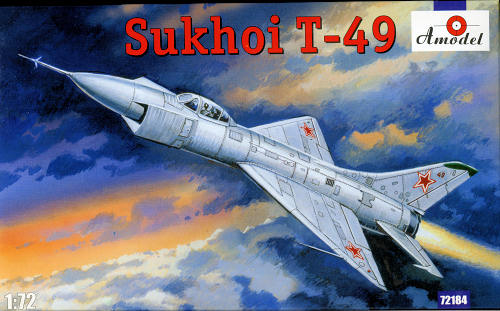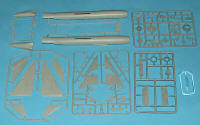
A-Model 1/72 Sukhoi T-49
| KIT #: | 72184 |
| PRICE: | $17.95 from http://www.scale-model-kits.com |
| DECALS: | One option |
| REVIEWER: | Scott Van Aken |
| NOTES: |

| HISTORY |
The Su-9 emerged from aerodynamic studies by TsAGI, the Soviet aerodynamic center, during the Korean War, which devised several optimum aerodynamic configurations for jet fighters. The design first flew in 1956 as the T-405 prototype. The Su-9 was developed at the same time as the Su-7 'Fitter', and both were first seen by the West at the Tushino Aviation Day on 24 June 1956, where the Su-9 was dubbed Fitter-B. It entered service in 1959.
Total production of the Su-9 was about 1,100 aircraft. It is believed that at least some Su-9s were upgraded to Su-11 'Fishpot-C' form. None were exported to any of the USSR's client states nor to the Warsaw Pact nations. Remaining Su-9s and later Su-11s were retired during the 1970s. Some were retained as test vehicles or converted to remote-piloted vehicles for use as unmanned aerial vehicles. It was replaced by the upgraded Su-11 and the much-superior Su-15 'Flagon' and MiG-25 'Foxbat'.
The combat record of the 'Fishpot,' if any, is unknown. It is possible that it was involved in the interception (or even shoot-down) of reconnaissance missions whose details remain classified, but nothing is publicly admitted.
It was reported that a Su-9 was involved in the interception of Francis Gary Powers' U-2 on Soviet territory on 1 May 1960. A newly manufactured Su-9 which was in transit flight happened to be near Powers' U-2. The Su-9 was unarmed and was directed to ram the U-2. One ramming attempt was made and the Su-9 missed the U-2, primarily due to large difference in the speed of the two planes. No further ramming attempt was made due to Su-9's lack of fuel.
On September 4, 1962 a modified Su-9 (designated T-431 by the bureau) piloted by Vladimir Sergeievitch Ilyushin set a new world record for absolute height, at 28,852 m (94,658 ft). In November of the same year Ilyushin set several new sustained speed/altitude records in the same aircraft
An attempt to improve performance by the use of what is called isoentropic air compression resulted in the rather odd looking T-49. This aircraft had two specially designed side intakes with the radar moved forward. This had the benefit of allowing a larger set to be installed, but in any regard, the 1960 flight test program was a failure as much due to the lack of a powerful enough engine as anything.
| THE KIT |
 It will surprise few that what one gets with this kit is basically the Su-9 with a modified forward fuselage and a new sprue for the rest of the intakes and radome. There is tons of room for weight so tail sitting should not be an issue. The medium grey plastic is a bit softer than the norm with average size sprue gates. Many pieces have some flash and I found some sink areas as well. Not a problem as A-Model kits are generally treated as short run kits. Like most that have been around for a while, the kit have been steadily improving and those who built one of their first kits would be quite pleased with how far they have come.
It will surprise few that what one gets with this kit is basically the Su-9 with a modified forward fuselage and a new sprue for the rest of the intakes and radome. There is tons of room for weight so tail sitting should not be an issue. The medium grey plastic is a bit softer than the norm with average size sprue gates. Many pieces have some flash and I found some sink areas as well. Not a problem as A-Model kits are generally treated as short run kits. Like most that have been around for a while, the kit have been steadily improving and those who built one of their first kits would be quite pleased with how far they have come.
Not surprisingly, there are several bits and pieces that are not used. No weapons are included as the plane had neither weapons nor pylons on which to put them. There is an adequate cockpit with a nice bang seat and detail on the sidewalls of the tub, which is built up of several pieces. Fitting the nose section and intakes will probably be the greatest challenge of the built. This is one area where the modeler will need to do test fitting to be sure all is properly aligned. There is no long intake trunking, but the blanking plate for the exhaust should prevent any see-thorough situation. The kit also has adequate wheel well detail, though it seems to me that the main gear wells are too shallow. Most of us won't really care about that, but I thought I'd mention it.
Landing gear components are quite sturdy. The nose gear leg and wheel is molded in one piece and if one so chooses, the model can be built wheels up. The gear doors need to be cut apart for a gear down  display. The canopy is a single piece and well molded. The many external intake scoops are separate
display. The canopy is a single piece and well molded. The many external intake scoops are separate
Instructions are well illustrated with Humbrol paint references. One markings option, that for the lone prototype. It is in unpainted metal. No bort number, just insignia and stencils. The markings placement guide is well done and show were all are to be installed. The well printed decal sheet also includes an instrument panel decal, which I know many of us will appreciate.
| CONCLUSIONS |
Another interesting Russian aircraft from our friends at A-model. If you like something a bit off the beaten track, then these kits are ones you should seriously consider.
| REFERENCES |
Kit instructions. June 2009 Thanks to http://www.scale-model-kits.com for the preview sample. Get yours today at a good discount. If you would like your product reviewed fairly and fairly quickly, please contact the editor or see other details in the